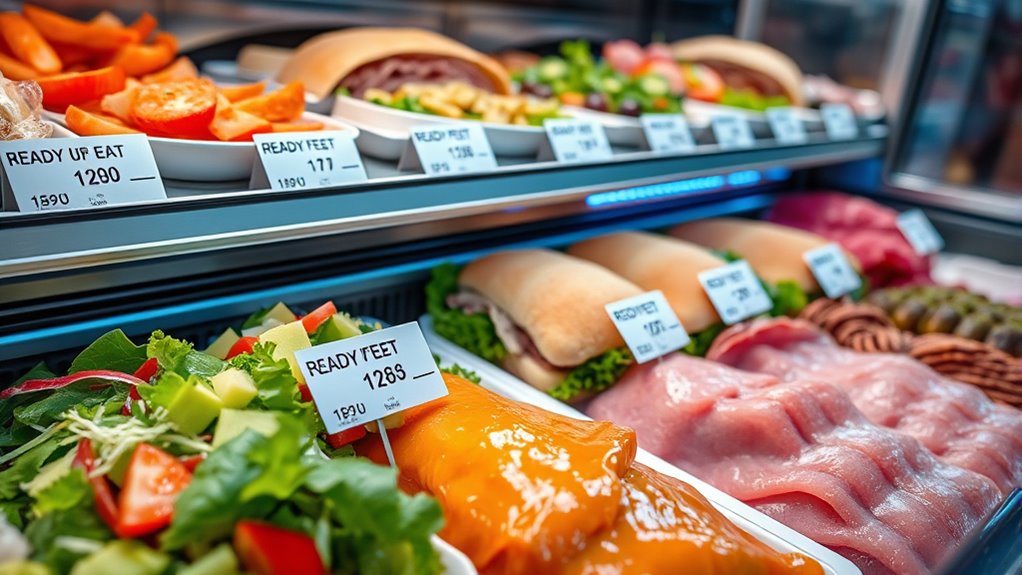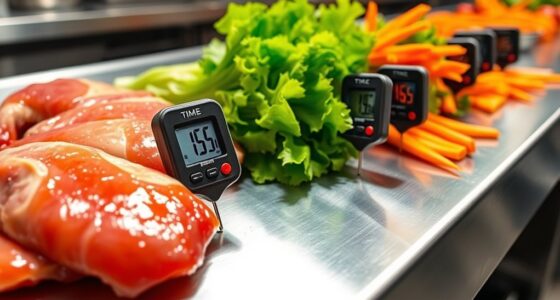For ready-to-eat foods, you need to clearly display date marks like “use by,” “sell by,” or “best before” on each package to guarantee safety and quality. These labels help you manage inventory properly, prevent serving or selling expired products, and comply with regulations. Accurate and visible dates build trust with customers and reduce waste. If you want to know the specific requirements and best practices, continue exploring how to implement effective date marking.
Key Takeaways
- Ready-to-eat foods must have clear, visible date labels indicating their “use by,” “sell by,” or “best before” dates.
- The labeling must accurately reflect the product’s shelf life based on scientific data and storage conditions.
- “Use by” dates are mandatory for safety, while “best before” dates are for quality, not safety.
- Labels should be consistent, legible, and comply with regulatory standards for proper food safety management.
- Proper date marking helps prevent the sale or consumption of unsafe products, ensuring consumer safety and regulatory compliance.

Understanding date marking requirements is essential for ensuring food safety and quality. When you’re handling ready-to-eat foods, clear and accurate food labeling helps both you and your customers know how long the product remains safe to consume. Proper date marking isn’t just about compliance; it’s about preventing foodborne illnesses and reducing waste. By following the shelf life guidelines set by regulations, you can confidently manage inventory, avoid offering expired products, and maintain trust with your customers.
Proper date marking ensures food safety, reduces waste, and builds customer trust by clearly indicating product freshness and safety.
Food labeling on ready-to-eat foods must include specific date marks, such as “use by,” “sell by,” or “best before” dates. These labels inform consumers about the product’s freshness and safety. The terms are not interchangeable, so it’s important to understand which date applies to the product and how each influences the product’s shelf life. A “use by” date, for example, is typically the last date recommended for consumption for safety reasons, while “best before” indicates when the product may start to lose quality but remains safe to eat for a period afterward. As someone responsible for food safety, you need to ensure that these labels are accurate and clearly visible on each package.
Shelf life guidelines play a significant role in determining how long ready-to-eat foods can be stored safely. These guidelines are based on scientific data and regulatory standards that consider factors like storage temperature, packaging, and the nature of the food. Knowing these shelf life guidelines allows you to set proper storage times and discard products before they become unsafe. It’s essential to monitor expiration dates regularly and implement a systematic approach to rotating stock, so older items are used first and no expired products remain on shelves.
Proper food labeling that aligns with shelf life guidelines also helps reduce food waste. When you accurately mark the expiration or best before dates, you give yourself and your staff clear instructions on when to remove products. This reduces the risk of serving or selling expired foods, which can harm your reputation and result in regulatory penalties. Additionally, customers rely on these labels to make informed choices, and providing transparent, accurate date markings builds trust and ensures compliance with food safety laws.
Frequently Asked Questions
Are There Exceptions for Homemade Ready-To-Eat Foods?
You can use homemade labeling and custom date practices for homemade ready-to-eat foods, but only if you follow specific guidelines. You must include the date the food was prepared and guarantee it’s consumed within the safe time frame. Always check local regulations, as some health departments may have stricter rules. Proper labeling helps prevent foodborne illnesses and keeps consumers informed about food freshness and safety.
How Should Date Markings Be Displayed on Packaging?
You should display date markings clearly on the packaging, ensuring labeling clarity and easy readability. Use contrasting colors and a legible font size, placing the date in a prominent location on the packaging design. Include both the discard date and the pack date if required. This helps consumers quickly understand the product’s freshness, complying with regulations and promoting safe consumption. Properly labeled packaging builds trust and reduces food waste.
What Are the Penalties for Non-Compliance?
Like a warning from a cautious lighthouse, non-compliance with expiration labels can lead to serious penalties. You risk fines, product recalls, and even legal action if you disregard date marking laws. Regulatory agencies prioritize consumer safety, so failing to follow these rules can damage your reputation and lead to costly consequences. Staying compliant ensures you avoid penalties and maintain trust, keeping your food business afloat and your customers safe.
Do Different States Have Varying Date Marking Laws?
You’ll find that state regulations on date marking laws do vary, so it’s essential to stay updated on local rules. Some states require specific date labels for ready-to-eat foods, while others have more general guidelines. To guarantee compliance, you should focus on label consistency across your products and check with state authorities regularly. This way, you avoid penalties and maintain safe, properly labeled food items.
How Often Should Date Markings Be Updated?
Think of expiration labels as the heartbeat of food safety—keeping everything in rhythm. You should update date markings whenever you open a package or when the storage duration has passed. Regularly check these labels to ensure freshness and prevent spoilage. By staying vigilant, you guarantee that ready-to-eat foods are safe to enjoy, and your storage practices stay on track with health standards.
Conclusion
Understanding date marking is essential for keeping ready-to-eat foods safe. Did you know that nearly 20% of foodborne illnesses are linked to improperly labeled products? By following proper date marking requirements, you help prevent food waste and protect your health. Stay vigilant, check labels regularly, and always adhere to storage guidelines. Your attention to these details can make a real difference in maintaining food safety and reducing unnecessary waste in your home.









